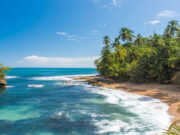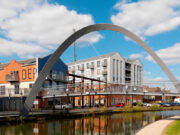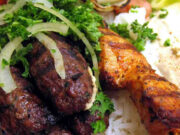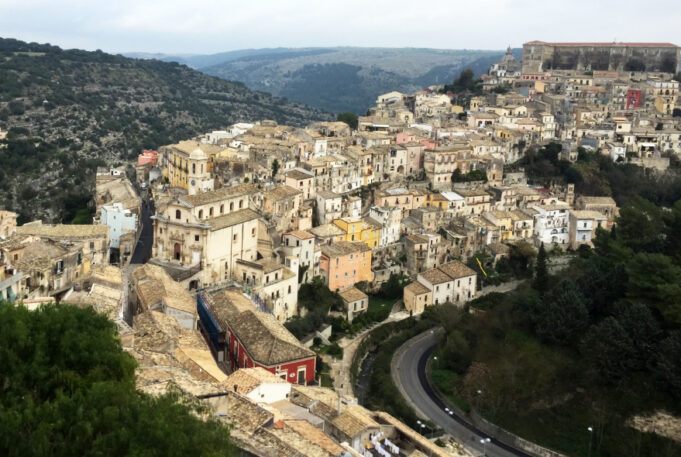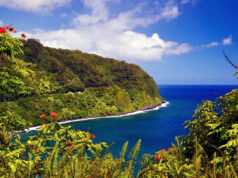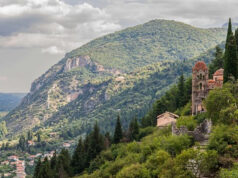Sicily is the biggest island in the Mediterranean Sea and a true open air museum showcasing more than 260 ancient archeological sites such as temples, amphitheaters, fortresses, towers and churches. To add to the splendor, a crystal clear sea frames the island and its treasures.
In December 2015, I accompanied my parents on a week-long trip to the eastern part of Sicily. We wanted to spend the holidays away from our surprisingly foggy home in Florence, Tuscany, and Sicily turned out to be the perfect escape.
Even though we had already traveled to Sicily a few years before, this trip was intended for us to discover a completely different side of Italy. Due to the invasions of Roman, Vandal, Byzantine, Islamic, Norman, Catalan and Spanish armies since the 8th century BC, the region now reflects the cultural nuances that each group left behind. In just one city, you can find Arabian palaces, Baroque churches, Roman amphitheaters and Grecian theaters.


Caption: The Greek theatre of Taormina
This timeless fusion of culture can best be seen in the town of Taormina, where we decided to begin our Sicily adventure. Here we got lost in the boutique-lined main streets and medieval narrow alleys, where the branches of orange trees and oleanders leaned out from private residences. When we arrived at the town’s main vista covered in cactus and surrounded by jagged cliffs, the balcony of the Piazza IX Aprile offered a stunning view of the sea and Mt. Etna. White puffs of smoke rose from the volcano’s snowcapped edges and into the blue sky. In the square, we were surrounded by the splendor of Saint Giuseppe church, Saint Agostino church (now a library) and the Torre dell’Orologio balustraded clock tower. The tower seemed a gateway to another time as its delicate archway welcomed travelers to the older neighborhoods of the town.
It is not a coincidence that writers have extolled Taormina’s beauty almost since it was founded in the 6th century BC. The more streets we strolled in Taormina, the more bucolic it felt. Cafes with outdoor spaces and local specialties speckled the city center streets. We loved the harmonious fusion of medieval, renaissance and baroque architectural styles. Nearby we could see Giardini Naxos, the first Greek colony in Sicily in 735 BC. The colony was a subtle reminder of the changes that the town had seen. My parents and I found that Taormina embodied the passion, the sophistication and rustic warmth of the Mediterranean. For my mom, Taormina was like a fresh floral perfume. For me, the city’s atmosphere was vivacious and radiant with the fusion of ancient styles laced in a delicate femininity. It wasn’t hard to see how so many had fallen in love with the area and why they didn’t want to leave.

Caption: Baroque style domintes the Valley of Noto
We continued our Sicily trip from Taormina to the Baroque valley of Noto. The valley forms part of a UNESCO heritage site and includes the cities of Caltagirone, Catania, Militello in Val di Catania, Modica, Noto, Palazzolo Acreide, Ragusa and Scicli. Small settlements perched on hilltops, their golden monuments glowing with the Sicilian sunshine, could be seen from miles away. These cities were meant to be seen, celebrated and adored. This tiny but opulent Baroque jewel is the result of the efforts to rebuild after a devastating earthquake in 1693. In Noto in particular, the atmosphere felt like a luxurious treat. In a region populated by olive and almond trees, it sits on a plateau dominating the valley of the Asinara and its citrus plantations. We enjoyed driving our car through the valley and admiring every nook. Each site seemed an outstanding testimony of the exuberant genius of late Baroque art and architecture.

Caption: The Valley of Noto
The richness and the sensuality of Sicily is not limited to its monuments or natural attractions. The freshness of the local tastes and the gastronomic varieties make the island a must-experience destination, and for that, we specifically visited the Baroque town of Modica, the home of a very special chocolate. The story of Modica’s chocolate goes back to the 16th century when the Spanish introduced cocoa seeds from Mexico to the region, which was then considered to be the most economically and culturally influential part of the Kingdom of Sicily. Regarded as a source of strength, vigour and a sign of wealth, chocolate became popular among Modica’s citizens and is still prepared today using the traditional Aztec method. Modica chocolate has remained unchanged through the centuries and has never become industrially produced. I couldn’t resist chocolate tastings offered by some of the tiny food shops in the town, and I was pleasantly surprised.

Caption: A Mpanatigghi from Modica. Photo credit: Pond 5
My curiosity on the subject was satisfied by the owner of a local gelateria selling Modica chocolate. With typical Sicilian pride and warmth, he explained to us that, unlike common chocolate, the mass of semi-ground cocoa mixed with castor sugar and cinnamon or vanilla is kept at cold temperatures that prevent the sugar crystals from melting. I was in love with this chocolate: it had a rough and dull look on its surface with visible sugar grains, a crumbly consistency and the shine of a polished marble inside. The strength of this product is the simplicity of the technique and the fact that there isn’t additional butter or other extraneous substances. For me, Modica chocolate represents the essence of Sicily: a rustic, luxurious and tasty gem. To quote Leonardo Sciascia in La Contea di Modica, “the flavour of Modica’s chocolate is so unique that whoever tastes it seems to have arrived at the archetype, the absolute, and the chocolate produced elsewhere – even the most famous – seems to be an adulterated or corrupted version.”
During our visit, I also had the pleasure of discovering another interesting Modica tradition: the so-called Mpanatigghi. The name was created from the phonetic distortion of “empanadas.” Along with cocoa seeds, the Spanish brought empanadas to Sicily in the 16th century. Sicilians made their own version of it years later. These half-moon shaped cookies have a thin crust and are filled with sugar, bitter chocolate, almonds, lemon, eggs, cinnamon and vanilla, as well as a secret ingredient: minced beef… That’s right. Beef is in these cookies for chocolate lovers of all kinds, like myself!
Caption: Pasta with fresh tuna, mint and tomates served in a sea shell
If a foreigner asked me where to travel in Italy, I would undoubtedly suggest Sicily. The beauty of its beaches, mountains, hills and archeological sites surely put Sicily on a traveler’s radar, but beauty alone doesn’t do the trick. What entices travelers to the island is the food – the best culinary traditions of the world. My parents and I, although coming from another Italian paradise, Tuscany, agreed on this: the charm of the Sicilian countryside, the variety of seasonal fruits and vegetables, the freshness of fish and meats and above all, the way such food is prepared, is unique. It amazed us to learn how Sicilians have continued to follow recipes acquired from ancient invading cultures. Such a cornucopia of contrasts made us truly fall in love with this land.
Article and photos by Giulia Grazzini.




